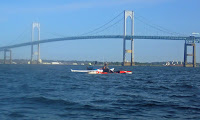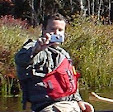You’ve been paddling your kayak on rivers and lakes, and now you want to venture out along the coast. Whether along sandy beaches, the rocky coast or open waters, sea kayaking provides the perfect blend of stunning views and unpredictable conditions that will allow you to experience paddling in a whole new way. For flatwater paddlers looking to add sea kayaking to their repertoire, here are some of the issues that need to be considered.You’ll need a sea kayak
To paddle in this unique environment, you will need a specialized boat. Sea kayaks are designed for long-distance cruising with water-tight bulkheads for ease of emptying in the event of capsize, perimeter deck lines for use during self or assisted rescues, skegs or rudders to assist tracking in the wind, and foot pegs to help transfer paddling power to the boat.
Other equipment
As you move out into open water you will also need a spray skirt, pump, paddle float and appropriate clothing for the conditions. Of course, you must always wear your PFD.
Conditions you will face
What really differentiates sea kayaking from flatwater paddling are the dynamic conditions that you encounter in open water driven by wind, waves and currents.
Waves – paddling through waves is inevitable when paddling on salt water. Waves can be tidal, wind-blown, or boat wake, and are often all three. Small rolling waves are relatively easy to navigate, but larger waves or breaking waves can be more difficult - especially as you start out.
Wind – wind has a much bigger impact on salt water than on all but the largest of fresh water lakes. A southwest wind that might make paddling more difficult on a small lake or river can quickly create large waves in more exposed coastal environments. Winds can also push you off course and be difficult to paddle against.
Current - Tidal currents are caused by the vertical motion of tides near the shore. The movement of the water depends on whether the tide is coming in or going out, and the currents are strongest as the water passes through obstructions that restrict its flow. The strongest currents typically occur around the time of high and low tides
Skills you’ll need
Paddling in these conditions is fun, but requires strong paddling skills. In addition to basic strokes, you will need to master advanced maneuvers like edging, bracing and ruddering. Taking a class with a certified instructor can help get your paddling technique up to good standard. The Kayak Centre offers classes on basic and advanced strokes. Kayak Wavology also provides basic and advanced training.
And it isn’t just stronger paddling skills that you will need as you progress into sea kayaking. More advanced trips will require reliable rescue skills, and knowledge of navigation and marine communication. Being prepared is key, and this especially true on the ocean where conditions can often be unpredictable.
Getting out on trips
As you progress, the best way to experience new and challenging conditions is to get out there and be exposed to them, but do so in incremental steps with other paddlers who are experienced in the conditions. You should assess your comfort level for participating in a trip based on the difficulty level, the forecasted conditions, your skills and experience, and your comfort with the other participants in the group. Each participant shares the responsibility for the group’s safety and enjoyment with the entire group.


























